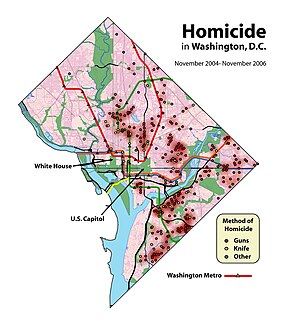
Esri is an international supplier of geographic information system (GIS) software, web GIS and geodatabase management applications. The company is headquartered in Redlands, California.

ArcIMS is a Web Map Server produced by Esri accessible through a web browser. It is a GIS that is designed to serve maps across the Internet. Sometimes these maps are just static images allowing simple panning and zooming, while others are more complex pages. Examples of interactive maps served with ArcIMS include maps with layers that can be turned on and off, or with features containing attributes that can be queried.

Crime mapping is used by analysts in law enforcement agencies to map, visualize, and analyze crime incident patterns. It is a key component of crime analysis and the CompStat policing strategy. Mapping crime, using Geographic Information Systems (GIS), allows crime analysts to identify crime hot spots, along with other trends and patterns.

Jack Dangermond is an American billionaire businessman and environmental scientist. In 1969, he co-founded with his wife Laura the Environmental Systems Research Institute (Esri), a privately held geographic information systems (GIS) software company.

ArcView GIS was a geographic information system software product produced by ESRI. It was replaced by new product line, ArcGIS, in 2000. Regardless of it being discontinued and replaced, some users still find the software useful and hold the opinion it is a superior product for some tasks.
Spatial network analysis software packages are computer tools used to prepare various graph-based analysis of spatial networks. They stem from various research fields in transportation, architecture and urban planning. The earliest examples of spatial network analysis using computers include the work of Garrison (1962), Kansky (1963), Levin (1964), Harary (1969), Rittel (1967), Tabor (1970) and others in the 1960s and 70s. Various fields of study have later developed specific spatial analysis software to suit their needs, including TransCAD among transportation researchers, GIS among planners and geographers, Axman among Space Syntax researchers, and various plugins for other software platforms. The list below gives and overview of some of the available software. Many of these were developed in academia and are freely available or freely available for academic research.
ArcSDE is a server-software sub-system that aims to enable the usage of Relational Database Management Systems for spatial data. The spatial data may then be used as part of a geodatabase.

The shapefile format is a popular geospatial vector data format for geographic information system (GIS) software. It is developed and regulated by Esri as a (mostly) open specification for data interoperability among Esri and other GIS software products. The shapefile format can spatially describe vector features: points, lines, and polygons, representing, for example, water wells, rivers, and lakes. Each item usually has attributes that describe it, such as name or temperature.
ArcInfo is a full-featured geographic information system produced by Esri, and is the highest level of licensing in the ArcGIS Desktop product line. It was originally a command-line based system. The command-line processing abilities are now available through the GUI of the ArcGIS Desktop product.
In cartography, rubbersheeting refers to the process by which a layer is distorted to allow it to be seamlessly joined to an adjacent geographic layer of matching imagery, such as satellite imagery which are digital maps. This is sometimes referred to as image-to-vector conflation. Often this has to be done when layers created from adjacent map sheets are joined together. Rubber-sheeting is necessary because the imagery and the vector data will rarely match up correctly due to various reasons, such as the angle at which the image was taken, the curvature of the surface of the earth, minor movements in the imaging platform, and other errors in the imagery.
ArcGIS Server is the core server geographic information system (GIS) software made by Esri. ArcGIS Server is used for creating and managing GIS Web services, applications, and data. ArcGIS Server is typically deployed on-premises within the organization’s service-oriented architecture (SOA) or off-premises in a cloud computing environment.
ArcMap is the main component of Esri's ArcGIS suite of geospatial processing programs, and is used primarily to view, edit, create, and analyze geospatial data. ArcMap allows the user to explore data within a data set, symbolize features accordingly, and create maps. This is done through two distinct sections of the program, the table of contents and the data frame.
ArcEditor is the midlevel software suite designed for advanced editing of spatial data published in the proprietary Esri format. It is part of the ArcGIS product. It provides tools for the creation of map and spatial data used in Geospatial Information Systems. ArcEditor is not intended for advanced spatial analysis, which can be performed using the highest level of ArcGIS, ArcInfo.
ArcView is the entry level licensing level of ArcGIS Desktop, a geographic information system software product produced by Esri. It is intended by Esri to be the logical migration path from ArcView 3.x.
MapDotNet is a suite of geographic information system (GIS) software products developed by ISC that run on Microsoft Windows. The GIS software competes with ESRI and MapInfo GIS products. MapDotNet UX is the latest generation and consists of a set of WCF web services for rendering map images and tiles and for performing spatial analysis and editing. UX includes an SDK for developing rich interactive mapping applications on Microsoft Silverlight, Windows Presentation Foundation and HTML5. MapDotNet UX also includes an Extract, Transform & Load (ETL), map design and tile cache creation tool called Studio modeled after Microsoft's Expression series of products. The MapDotNet UX renderer is built on WPF and consumes spatial data from multiple sources including Shapefiles, PostGIS, ArcSDE, Oracle Spatial, SQL Azure, SQL Server 2008 R2 and SQL Server 2012.
InstantAtlas is a data visualization and reporting tool used for communicating location-based statistical data held in spreadsheets and desktop Geographic Information System software. InstantAtlas is used by analysts, researchers, statisticians and GIS professionals. It provides tools to load data into pre-built templates, then tailor and brand the outputs, dynamic reports, to meet an almost infinite range of styles and audience capabilities. The dynamic reports utilise a range of graphical data presentation techniques to present a rich and intuitive picture of the data allowing end-users to discover patterns, trends, relationships and anomalies. The dynamic reports are examples of Rich Internet applications (RIAs). They are often described by customers as interactive atlases, area profiles, performance dashboards, and scorecards.
Geographic information systems (GIS) play a constantly evolving role in geospatial intelligence (GEOINT) and United States national security. These technologies allow a user to efficiently manage, analyze, and produce geospatial data, to combine GEOINT with other forms of intelligence collection, and to perform highly developed analysis and visual production of geospatial data. Therefore, GIS produces up-to-date and more reliable GEOINT to reduce uncertainty for a decisionmaker. Since GIS programs are Web-enabled, a user can constantly work with a decision maker to solve their GEOINT and national security related problems from anywhere in the world. There are many types of GIS software used in GEOINT and national security, such as Google Earth, ERDAS IMAGINE, GeoNetwork opensource, and Esri ArcGIS.
Esri Canada is the Canadian provider of enterprise geographic information system (GIS) solutions from Esri. GIS allows multiple layers of information to be displayed on a single map. Esri Canada’s solutions are based on ArcGIS technology. The company also distributes vertical-focused solutions from technology partners such as Schneider Electric. A third of its offerings are professional services.







